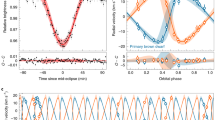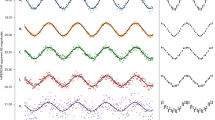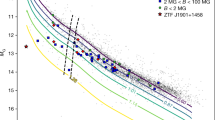Abstract
BROWN dwarfs are starlike objects with masses less than 0.08 times that of the Sun, which are unable to sustain hydrogen fusion in their interiors1–4. They are very hard to detect, as most of the energy of gravitational contraction is radiated away within ∼108 yr, leaving only a very low residual luminosity. Accordingly, almost all searches for brown dwarfs have been directed towards clusters of young stars—a strategy that has recently proved successful5,6. But there are only modest observable differences between young brown dwarfs and very lowmass stars, making it difficult to identify the former without appealing to sophisticated models7. Older brown dwarfs should have a more distinctive appearance, and if they are companions to nearby stars, their luminosity can be determined unambiguously. Here we report the discovery of a probable companion to the nearby star G1229, with no more than onetenth the luminosity of the least luminous hydro-gen-burning star. We conclude that the companion, G1229B, is a brown dwarf with a temperature of less than 1,200 K, and a mass ∼20–50 times that of Jupiter.
This is a preview of subscription content, access via your institution
Access options
Subscribe to this journal
Receive 51 print issues and online access
$199.00 per year
only $3.90 per issue
Buy this article
- Purchase on Springer Link
- Instant access to full article PDF
Prices may be subject to local taxes which are calculated during checkout
Similar content being viewed by others
References
Kumar, S. S. Astrophys. J. 137, 1121–1126 (1963).
Tartar, J. C. in Astrophysics of Brown Dwarfs (eds Kafatos, M. C., Harrington, R. S. & Maran, S. P.) 121–138 (Cambridge Univ. Press, 1986).
Stevenson, D. J. A. Rev. Astr. Astrophys. 29, 163–193 (1991).
Burrows, A. & Liebert, J. Rev. mod. Phys. 65, 301–336 (1993).
Basri, G., Marcy, G. W. & Graham, J. R. Astrophys. J. (in the press).
Rebolo, R., Zapatero Osorio, M. R. & Martin, E. L. Nature 377, 129–131 (1995).
Magazzù A., Martin, E. L. & Rebolo, R. Astrophys. J. 404, L17–L20 (1993).
Nakajima, T., Durrance, S. T., Golimowski, D. A. & Kulkarni, S. R. Astrophys. J. 428, 797–804 (1994).
Leggett, S. K. Astrophys. J. Suppl. Ser. 82, 351–394 (1992).
Hawley, S. L. in The Bottom of the Main Sequence—and Beyond (ed. Tinney, C. G.) 224–227 (Springer, Berlin, 1995).
Pallavicini, R. Astr. Astrophys. Rev. 1, 177–207 (1989).
Gliese, W. & Jahreiss, H. Preliminary Version of the Third Catalog of Nearby Stars (1991).
Reid, I. N., Hawley, S. L. & Mateo, M. Mon. Not. R. astr. Soc. 272, 828–842 (1995).
Golimowski, D. A., Clampin, M., Durrance, S. T. & Barkhouser, R. H. Appl. Opt. 31, 4405–4416 (1992).
Hirschfeld, A. & Sinnott, R. W. Sky Catalog 2000.0 Vol. 2 (Cambridge Univ. Press, Sky Publishing, Cambridge, 1995).
Tsuji, T., Ohnaka, K. & Aoki, W. in The Bottom of the Main Sequence—and Beyond (ed. Tinney, C. G.) 45–49 (Springer, Berlin. 1995).
Henry, T. J. & McCarthy, D. W. Astr. J. 106, 773–789 (1993).
Zuckerman, B. & Becklin, E. E. Astrophys. J. 386, 260–264 (1992).
Tinney, C. G., Mould, J. R. & Reid, I. N. Astr. J. 105, 1045–1059 (1993).
Allard, F. & Hauschildt, H. P. in The Bottom of the Main Sequence—and Beyond (ed. Tinney, C. G.) 32–40 (Springer, Berlin, 1995).
Oppenheimer, B. R., Kulkarni, S. R., Matthews, K. & Nakajima, T. Science (in the press).
Jones, H. R. A., Longmore, A. J., Jameson, R. F. & Mountain, C. M. Mon. Not. R. astr. Soc. 267, 413–423 (1994).
Author information
Authors and Affiliations
Rights and permissions
About this article
Cite this article
Nakajima, T., Oppenheimer, B., Kulkarni, S. et al. Discovery of a cool brown dwarf. Nature 378, 463–465 (1995). https://doi.org/10.1038/378463a0
Received:
Accepted:
Issue Date:
DOI: https://doi.org/10.1038/378463a0
This article is cited by
-
The origin of free-floating planets
Astrophysics and Space Science (2023)
-
Atmospheric Dynamics of Hot Giant Planets and Brown Dwarfs
Space Science Reviews (2020)
Comments
By submitting a comment you agree to abide by our Terms and Community Guidelines. If you find something abusive or that does not comply with our terms or guidelines please flag it as inappropriate.



